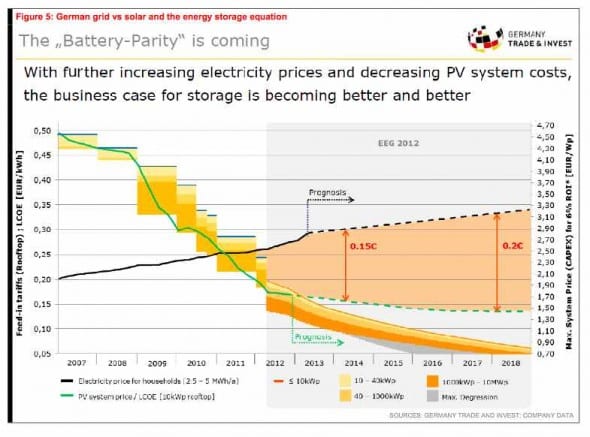
How far away is grid parity for residential battery storage?
It is now generally recognised that rooftop solar has reached “socket parity” – meaning it is comparable or cheaper than grid prices – in many countries over the last few years. The big question for consumers and utilities is when will socket parity arrive for solar and battery storage?
Some suggest it is years away. Others, such as UBS and the Rocky Mountain Institute, say it could arrive in Australia and the US within four to six years. It may come even earlier.
The graph below comes from Germany Trade and Invest and outlines the metric that will govern the arrival of grid parity for battery storage. Electricity prices are rising, solar PV prices are falling, which means that if battery storage can fall to around €0.20 per kilowatt hour, then parity will be achieved.
Australian research house Morgans, in an assessment of Brisbane-based battery storage developer Redflow, suggests that its zinc-bromine flow battery may already be commercially economic in Germany, which leads the world in terms of household adoption and government support for renewables.
Morgans notes that in Germany, the cost of household grid power is around €0.30 per kw hour ($A0.42/kWh) and the government is now subsidising residential energy storage systems that are connected to solar systems.
“Given Germany’s substantial adoption of solar PV their costs for solar power range from €0.10- €0.15 per kw hour (half the grid price) so when energy storage costs reach €0.15 -€0.20 this will mean renewable energy costs will be at parity with grid prices,” Morgans says.
The German government is currently subsidising up to €3,000 for energy storage systems. Morgans says that the €0.15 – €0.20 per kw hour range (discussed above in figure 5) for energy storage costs, combined with the German government’s €3,000 subsidy for energy storage systems means the RFX ZBM will be competitive if they can triple the cycle life.
“In our view this should be achievable,” it says.

How far away is grid parity for residential battery storage?
It is now generally recognised that rooftop solar has reached “socket parity” – meaning it is comparable or cheaper than grid prices – in many countries over the last few years. The big question for consumers and utilities is when will socket parity arrive for solar and battery storage?
Some suggest it is years away. Others, such as UBS and the Rocky Mountain Institute, say it could arrive in Australia and the US within four to six years. It may come even earlier.
The graph below comes from Germany Trade and Invest and outlines the metric that will govern the arrival of grid parity for battery storage. Electricity prices are rising, solar PV prices are falling, which means that if battery storage can fall to around €0.20 per kilowatt hour, then parity will be achieved.
Australian research house Morgans, in an assessment of Brisbane-based battery storage developer Redflow, suggests that its zinc-bromine flow battery may already be commercially economic in Germany, which leads the world in terms of household adoption and government support for renewables.
Morgans notes that in Germany, the cost of household grid power is around €0.30 per kw hour ($A0.42/kWh) and the government is now subsidising residential energy storage systems that are connected to solar systems.
“Given Germany’s substantial adoption of solar PV their costs for solar power range from €0.10- €0.15 per kw hour (half the grid price) so when energy storage costs reach €0.15 -€0.20 this will mean renewable energy costs will be at parity with grid prices,” Morgans says.
The German government is currently subsidising up to €3,000 for energy storage systems. Morgans says that the €0.15 – €0.20 per kw hour range (discussed above in figure 5) for energy storage costs, combined with the German government’s €3,000 subsidy for energy storage systems means the RFX ZBM will be competitive if they can triple the cycle life.
“In our view this should be achievable,” it says.

How far away is grid parity for residential battery storage?
It is now generally recognised that rooftop solar has reached “socket parity” – meaning it is comparable or cheaper than grid prices – in many countries over the last few years. The big question for consumers and utilities is when will socket parity arrive for solar and battery storage?
Some suggest it is years away. Others, such as UBS and the Rocky Mountain Institute, say it could arrive in Australia and the US within four to six years. It may come even earlier.
The graph below comes from Germany Trade and Invest and outlines the metric that will govern the arrival of grid parity for battery storage. Electricity prices are rising, solar PV prices are falling, which means that if battery storage can fall to around €0.20 per kilowatt hour, then parity will be achieved.
Australian research house Morgans, in an assessment of Brisbane-based battery storage developer Redflow, suggests that its zinc-bromine flow battery may already be commercially economic in Germany, which leads the world in terms of household adoption and government support for renewables.
Morgans notes that in Germany, the cost of household grid power is around €0.30 per kw hour ($A0.42/kWh) and the government is now subsidising residential energy storage systems that are connected to solar systems.
“Given Germany’s substantial adoption of solar PV their costs for solar power range from €0.10- €0.15 per kw hour (half the grid price) so when energy storage costs reach €0.15 -€0.20 this will mean renewable energy costs will be at parity with grid prices,” Morgans says.
The German government is currently subsidising up to €3,000 for energy storage systems. Morgans says that the €0.15 – €0.20 per kw hour range (discussed above in figure 5) for energy storage costs, combined with the German government’s €3,000 subsidy for energy storage systems means the RFX ZBM will be competitive if they can triple the cycle life.
“In our view this should be achievable,” it says.



